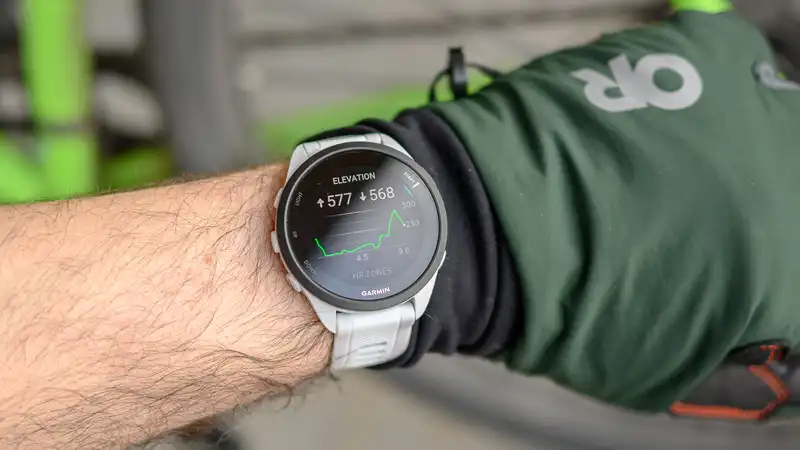There's a new fitness tracker in town: the Garmin Forerunner 165 in addition to my hands-on experience with this sporty new wearable, I had the opportunity to take a slightly soaking wet bike ride My mission, still wet behind the ears, was to test the accuracy of a sub-$300 wearable
But before I go in for the test, there are a few things you should know about the new Garmin Forerunner 165
The Forerunner 165 comes in two models: one with on-board music storage for $29999 and one without on-board music storage for $24999
Both feature easy-to-read 12-inch AMOLED screens, 11-day battery life, heart rate and SpO2 tracking, extensive physical buttons, and GPS In an attractive, lightweight package, users can choose from four fashionable styles
The Forerunner 165 sits above the entry-level Forerunner 55 and the mid-level Forerunner 265 It is also adjacent to the Vivoactive 5, a similar-looking device made for more casual users
And off to the test we go
For many runners, GPS is an essential feature of any wearable under consideration Why? Because it frees you from carrying a bulky smartphone without sacrificing location and distance data
I'm more of a pedaler than a pavement pedaler, but even if I had a nifty Peak Design smartphone mount for my bike, I would appreciate the above idea So this past weekend, when the skies briefly cleared, I put on my top-of-the-line bicycle helmet, strapped my Forerunner to my wrist, and rode through the mean streets of Seattle
To test the GPS accuracy, I also used my trusty Strava on my iPhone (12 Mini) during the ride Before I get into the results, a few notes about the ride
I started my trip from a parking lot with a clear view of the sky It took about 45 seconds to activate the Garmin GPS, find the satellites, and establish a healthy connection
As I rounded Seattle's Lake Union and entered Interlaken Park, I passed through an area with sky-scrapers, towering construction cranes, dense aerial power lines, and old-growth forests blocking the sky Come to think of it, the sky was overcast all the way, rain on and off This is Seattle in winter
This is a bike ride that I have completed many times (over 100) and often use when testing other fitness trackers There is a lot of useful data to compare Forerunner metrics such as average heart rate, maximum heart rate, pace, elevation gain, etc
Of course, these data points are not a one-to-one comparison because the rides are necessarily different However, they do show roughly how the Forerunner 165 stacks up against other trackers (such as the two top performance models)
Immediately, I was impressed with the accuracy of the Forerunner 165 and its distance department; a 004-mile discrepancy between the two devices translates to a mere 211 feet, or three-quarters the length of an American football field (for my British readers, that is roughly 17 the width of a cricket pitch)
If you live in a relatively flat area, the elevation difference is easy to overlook But in Seattle, hills are a way of life and a major part of my workout routine So accurate post-ride elevation data is a must
The Forerunner 165 has an altimeter, and my gain was 43 feet higher than Strava Without a third GPS-equipped device, I don't know which is more accurate However, my gut feeling is that the Garmin's numbers may be slightly inflated Still, the discrepancy is not enormous
On the flip side, the Garmin recorded an overall pace of 79 mph for my ride, much slower than Strava Considering the past few rides were in the neighborhood of 10 or 11 mph, I felt the Garmin was slow
One possible reason is that I stopped several times during the ride to take pictures of my watch; Strava automatically pauses tracking at these moments Garmin does not, or at least not by default But further investigation is needed
To get an idea of the heart rate accuracy, I looked back at recent bike tests of the Fitbit Inspire 3 and Polar Vantage V3 on the same bike route (and similar weather conditions)
Don't read too much into these numbers, but some days I feel like Beryl Burton and some days I feel like Dan Bracaglia
The low average heart rate was probably a result of the many stops and starts that slowed me down
Of course, this is only a brief assessment of the Garmin Forerunner 165 and its tracking capabilities In the coming weeks, the TG Fitness team will be testing it in a variety of scenarios, from rainy day runs to mountain hikes to late afternoon naps
So far, I have a pretty good feeling about the Forerunner 165 and its ability to track workouts accurately and reliably Then again, given its pedigree, perhaps accuracy is not surprising










Comments